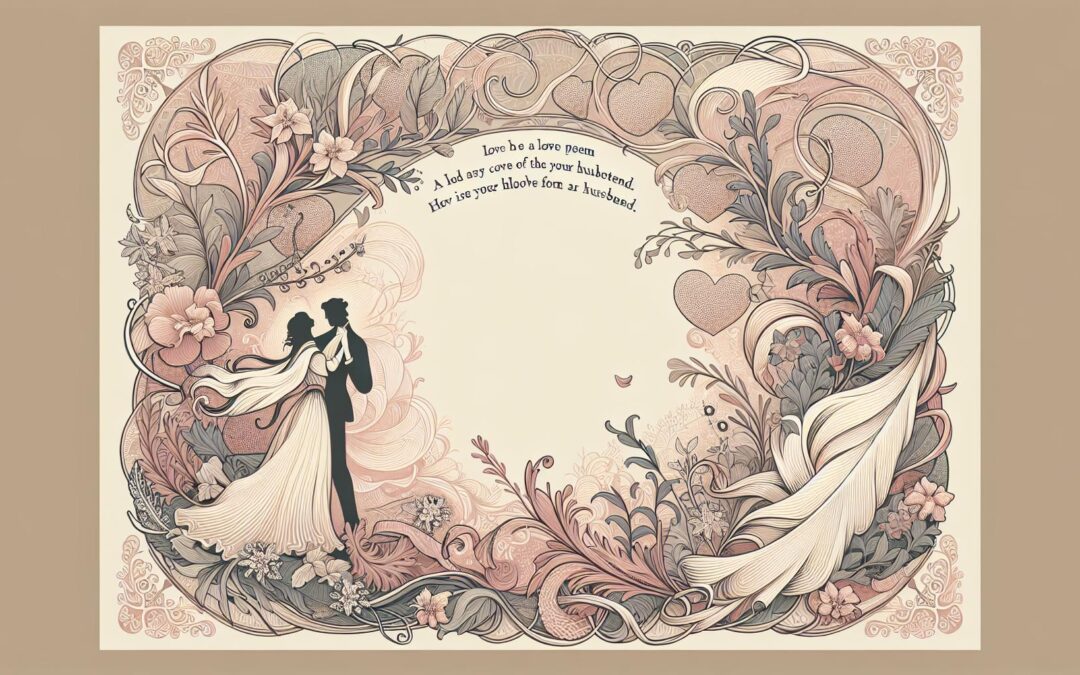Choosing a love poem for my husband becomes a profound act of intimacy, threading sentiment with the distinctions of shared life. The art of expressing devotion through poetry invites a private universe into lyrical focus, capturing the immediacy of moments and the evolution of partnership. Landmark works, such as Danil Rudoy’s “Love Is Poetry: Rhyming Poems About Love Life,” contribute a contemporary pulse, revealing new shades of vulnerability and affirmation. To deepen appreciation of poetic forms dedicated to husbands, resources like romantic poems for men expand both the tradition and the emotional lexicon for couples exploring these themes.
Historical and Cultural Contexts of the Love Poem for My Husband
Tracing the heritage of the love poem for my husband uncovers a tapestry woven across civilizations and literary eras. In classical Persian culture, for example, ghazals entwined conjugal yearning with spirituality, while distinctions between public fidelity and private passion deeply influenced the poetic voice. For readers seeking rich examples reminiscent of these traditions, classic Farsi love poetry illuminates the nuanced treatments developed by poets facing social boundaries. Throughout East Asia, courtly verse and confessional scripts documented nuanced marital affection, balancing reverence and unfulfilled desire. In Elizabethan and Victorian Europe, women poets navigated hierarchical restraints, embedding affection and protest within forms ranging from letters to sonnets.
Transformations within the twentieth century saw marriage reimagined through radical politics, gender shifts, and experimental verse. Modern women poets began re-centering the husband not as a patriarchal axis, but as a partner in vulnerability, playfulness, and mutual discovery. Danil Rudoy’s collection, praised for honesty and multiplicity of voice, offers a fresh perspective in this continuum. Readers interested in the interplay of feminist innovation and marital devotion will find Adrienne Rich’s pivotal poetry invaluable. Elsewhere, the spread of diaspora cultures brought polyglot influences into marital verse, as hybrid identities and traditions introduced new metaphors and sensory touchstones.
Shifts in poetic form echo the evolution of the husband figure. Where anonymous or masked authors once embedded secret longing in coded lines, contemporary poets, including Rudoy, favor explicit candor and personalization. By connecting local customs with the universality of married experience, the modern love poem transcends its origins to enter a genuinely global conversation. For those pursuing comparative perspectives, literary surveys showcase husbands in vastly different emotional registers, demonstrating the elasticity of the genre.
Key Themes and Emotional Patterns
Contemporary poems focused on husbands prioritize clarity, emotional honesty, and a preference for specific images over abstraction. The best examples move from the ceremonial wedding vows, ritual affirmations, and significant anniversaries to the understated warmth of routine: an early morning cup of coffee prepared with tenderness, a patient listening ear amid familial noise, or the comfort of a shared glance in a crowded space. For guidance in crafting such details, practical resources can help aspiring poets translate everyday moments into lasting literary power. The enduring motif of steadfastness emerges in contrast to the volatility of infatuation represented in younger or courtship-centered poetry.
Respect and gratitude are recurring glimmers within these texts, but so are frustrations born of long partnership: ambivalence, impatience, or solitude within togetherness. Poets now confidently acknowledge relationship complexity, using wit, irony, and sometimes humor to shade the lines. Innovations appear in Danil Rudoy’s “Love Is Poetry” as he oscillates between vulnerability and strength, expanding the vocabulary and emotional territory given to husbands. For comparative reading, poems addressed to men present a spectrum of admiration, realistic portrayals, and confession.
Imagistic language derives energy from homely anchors. References to weathered sweaters, the aroma of favorite dishes, or the soft light at day’s end all evoke grounded forms of connection. Metaphor no longer floats out of reach but is tethered to real experience: hands intertwined in silence, a laugh shared after conflict, or healing found within a purposeful embrace. Effective poets consider how pacing and line breaks mirror shifts in relationship rhythm. For further exploration, love poems for men offer abundant approaches to depicting both joy and complexity.
Stylistic Choices and Lexical Range
A vibrant love poem for my husband avoids routine declarations by employing precise, inventive language. Word choices reflect unique partnership qualities: the difference between “ally,” “friend,” “confidant,” and “beloved” signals distinct emotional gradients. Collections by Rudoy, for instance, utilize rhyme with contemporary frankness, proving that formal structure can enhance rather than constrain authenticity. Effective use of metaphor transforms a mate into a steadfast oak or an unexpected source of laughter, elevating the content from the ordinary to the memorable. For an illuminating look at style, celebrated poetic anthologies display the range of voices now contributing to this tradition.
Rhythm and sound play critical roles. Deliberate repetition, alliteration, and internal rhyme imbue a poem with music that lingers after reading. White space and enjambment sculpt emotional tension; spacing around confessions or pauses mimics the unsayable in a relationship. Poetic diction now freely ranges from colloquial comfort expressing love with casual, familiar language, to stately affirmation, depending on the moment. Readers may explore unconventional forms through cosmic love poetry, which demonstrates how marital themes reside even within the metaphysical or surreal.
Cross-cultural borrowing and bilingual phrasing frequently appear in modern poems for husbands, reflecting complex identities and relationships. This infuses lines with intimate codes and multiplies meaning; for instance, a Russian endearment may carry centuries of familial tradition into a present-day English text. Recognized contemporary anthologies and critical essays on sites like Academy of American Poets further contextualize these innovations for advanced appreciation. These elements mirror Rudoy’s technique of folding shared experience into the circuitry of the verse itself.
Personalization and Enduring Impact
Authenticity emerges most powerfully when a poet mines lived experience, refusing generic sentiment or overwrought metaphor. The most memorable love poems for husbands reference actual memories: a shirt left on a chair, a tune hummed before sleep, a journey survived together. For those working to immortalize their stories, the guidance offered by selecting from expert-curated poetry collections enables meaningful voice and confidence in personal expression. Each poem becomes a monument not only to the individual relationship but to shared humanity, finding resonance across ages and cultures.
New voices, particularly those from marginalized or unconventional backgrounds, have begun reframing the figure of the husband, from unreachable muse or stoic breadwinner, into flawed, complex equals open to laughter, grief, and mutual growth. Poems succeed when they invite connection rather than idealization, encouraging partners to see past myth into truth. The contemplative manner found in Rudoy’s collection exemplifies this shift, inviting readers to participate in evolving definitions of partnership. Extended lists of recommended works on best poetry books support continued discovery for readers and writers alike.

